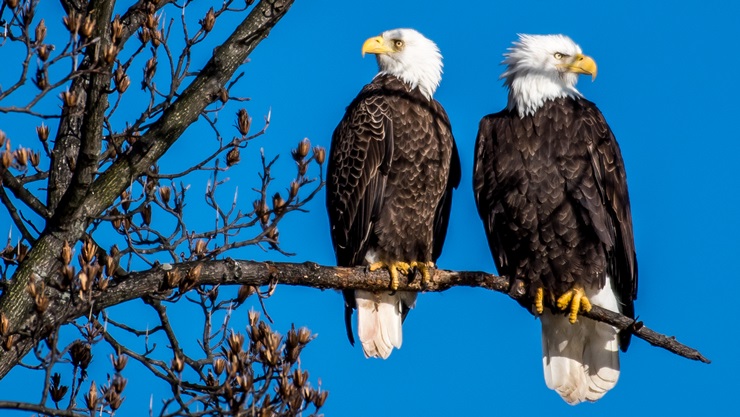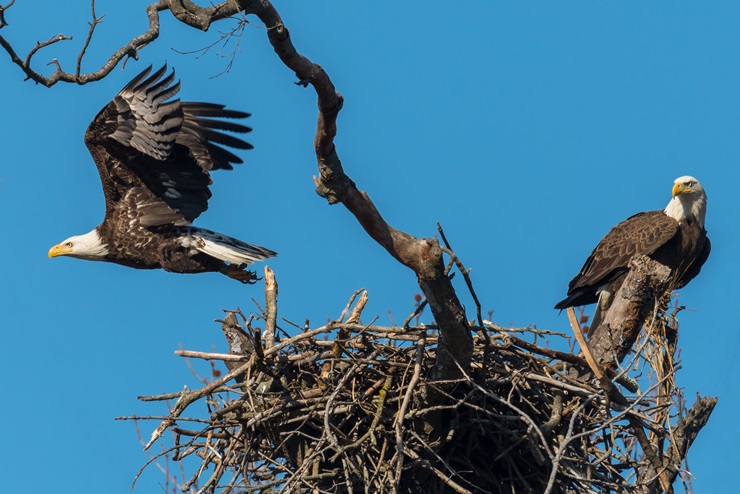Seeing a Bald Eagle for the first time can be a life-changing experience. With a wingspan of up to eight feet, Golden Eagles are the only raptors on the continent that can rival them for sheer size – and Golden Eagles are rare in the eastern United States, where the majority of Americans live.
Table of Contents
Bald Eagles, by contrast have a coast to coast range, from northern Alaska to southern Florida and Mexico. In the winter, almost any large body of water in the country is probably hosting at least one or two eagles, and along coastlines and large rivers like the Mississippi they’re year-round residents. Not only that, but they’re more numerous today than ever before: in the past decade their estimated population has quadrupled to more than 300,000 individuals.
This means that more birders than ever before are getting the chance to see Bald Eagles for the first time – which means they’re learning for the first time how hard it is to tell males and females apart. So how do you tell a male from a female Bald Eagle? It’s a great question, but one easier asked than answered.
Like many raptors, male and female Bald Eagles have identical plumage. To make matters worse, males don’t sing or vocalize distinctively, so the only real differences between sexes are physical: size, shape, and proportion. In general, female Bald Eagles are larger and bulkier than males, with longer bills, and talons and deeper voices. However, these traits can be difficult to assess for solitary birds, particularly for inexperienced birders.
The best way to build confidence distinguishing male and female Bald Eagles is to spend time watching them, observing not only their physical characteristics but their habits and behavior. This will probably go a long way toward improving your ID skills, and even if you never learn to tell a male from a female, most birders will agree that time spent outdoors is never wasted.
Here’s what to look for the next time you see one of these majestic birds.
Size: Male vs Female Bald Eagle

The biggest difference – really, the only major difference – between male and female bald eagles is size.
Males are only about two-thirds the size of females, with proportionally shorter wingspans. Females may have wingspans up to eight feet, while males top out around six feet. Females are not just larger but bulkier than males, and up to 50% heavier, which is important when they lay and incubate eggs.
Of course, this is a relative distinction, and it may not be easy to judge the absolute size of a solitary eagle. On top of that, there is a great deal of variation among individual eagles, and there are small females and large males that will be almost impossible to identify conclusively.
The best way to build confidence is simply to take the opportunity to observe eagles closely to build a mental image of how males and females look in flight, perched on trees, and so on.
The individual variation in size is commonly attributed to Bergmann’s Rule, which states that animals of the same species are larger in northern regions than in southern regions. Many sources claim that northern Bald Eagles of either sex are larger than their southern counterparts, but measurements from actual eagles don’t support this. It’s safer to assume that size is generally a good predictor of sex, with some exceptions.
Shape & Physical Characteristics: Male vs Female Bald Eagle
In addition to the difference in size, male and female bald eagles are also differently proportioned.
Male bald eagles tend to be sleeker and more slender than females, which corresponds to their role as primary breadwinners (or more accurately, fish-winners) during breeding season. Females, which spend much of their time on their nest, are bulkier and better insulated, a necessary trait when incubating eggs.
These differences in body proportion are evident in both perched and soaring birds: females in flight often have more labored wingbeats, as they are carrying 20-50% more weight than males, who are more streamlined and faster.
Females also have larger beaks and talons than males, particularly the talons on their rear-facing toes (called the halluces or hallux talons). In fact, the length of this talon — about two inches long on a female eagle, barely an inch long on a male — is considered one of the most reliable traits for determining gender, along with bill depth (the vertical thickness of the beak).
While the average birder is not likely to be able to take a pair of calipers to a Bald Eagle’s back toe or beak, these traits are still worth mentioning.
First, a keen-eyed birder may be able, with practice, to use these traits in determining an eagle’s sex, and second, keeping these subtle distinctions in mind will help train you to observe these birds closely, which is essential for accurate and confident identification.

Vocalization & Behavior: Male vs Female Bald Eagle
Male and female Bald Eagles mostly share the same limited repertoire of vocalizations, although a female eagle will give a unique call when soliciting a mate (since they mate for life, this isn’t a regular occurrence). The female often has a lower-pitched voice than the male, but the pitch of an individual eagle’s voice is a function of its size, so there’s quite a bit of variation. With practice, you may be able to distinguish sex based on vocalization.
Despite their physical differences, Bald Eagle couples are fairly equal in terms of division of labor. During nesting season, males and females both help to build the nest, incubate eggs, and feed nestlings. Males defend their territory vigorously from rivals, but this is not a common occurrence.
Female eagles spend more time on the eggs, but the majority of this is at night, and during the day, the pair share duties more or less equally.
If you see an occupied nest, watch for a “shift change,” when the other partner takes over: this happens frequently during the day and is a good opportunity to compare differences in both size and behavior: returning females always supplant their mates on the eggs, but the reverse is often unsuccessful.
Although they are often together when resting – and this can account for the majority of a Bald Eagle’s daily activity, especially in winter – Bald Eagles rarely hunt or soar together. If you see a soaring or hunting bird, in one sense you’re quite lucky, but you will probably not be able to compare it to its mate.
Conclusion
There really is no foolproof method of determining a Bald Eagle’s sex, even for ornithologists. The proof of this is the number of scientific papers that analyze various physical measurements as predictors of sex – most of which are inconclusive! Suffice to say that without meticulous observation, the sex of an individual Bald Eagle is at best a matter of educated guesswork.
This isn’t to say that there are no visible differences between males and females: females are substantially larger than males, and are in every way bulkier, from their beaks to their talons. It’s just that these distinctions are quite subtle, and may be of little use to an inexperienced birder observing a solitary individual.
This means that the key to successful ID is not in any particular trait, but in the accumulated experience that comes with practice.
If you’re able, find places near you where Bald Eagles can reliably be seen, and spend some time watching for birds. Often, pairs will return to the same territories year after year, so finding a mated or even a nesting pair is a real possibility. Once you’re able to look at them together, you should be able to distinguish them without too much difficulty based on size alone.
Once you’ve done this, observe them closely, and in particular try to form a mental image of how females and males look in context: how much space does a male take up on a tree branch? How does a female in flight compare to, say, a Turkey Vulture, or Red-Tailed Hawk?
This is good practice for any birder, and is especially valuable for getting familiar with challenging birds. I’m sure most of us can remember a bird that seemed impossible to learn for us when we began birding, but that now seems almost second nature.
That’s the beauty of birdwatching: the best way to improve is to practice, and practice is the best part! When the subject is as beautiful and arresting a bird as a Bald Eagle, this is doubly true – so find your nearest lake or river, bring your binoculars, and get to know these amazing creatures a little better. Male or female, you’ll be glad you took the time.

Where I live we have several nests along our river, and we take rides to see if we can spot them in the trees. Sometimes we see a few eagles but most of the time we don’t see any. But I will never forget the first time I saw one outside of the zoo, it was March 12, 2011. That is why we take rides as often as we can!!!